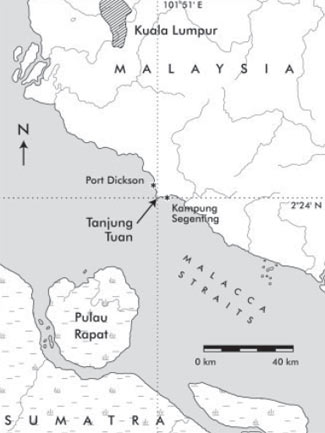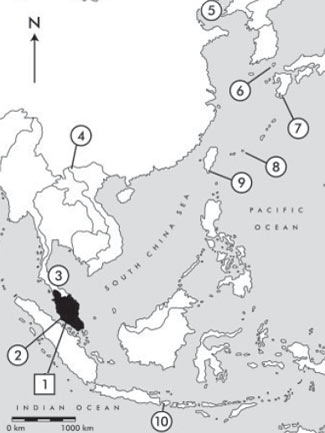
|
||||||||||
|
||||||||||
| Favorite Tweets by @thaibirding | ||||||||||
|
||||||||||
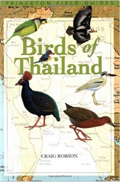 Buy Birds of Thailand on Amazon.co.uk |
||||||||||
| Site Map ; Contributors |
| Spring
migration of Oriental Honey-buzzards Pernis ptilorhyncus
and other raptors at Tanjung Tuan, Malaysia, 2000–2001 By Robert DeCandido, Deborah Allen and Keith L. Bildstein |
||||
| Tweet | ||||
| Note:
This article was originally published in Forktail 22 (2006) the journal
of the Oriental
Bird Club (OBC) and was kindly submitted by Robert
DeCandido. Please support the OBC's conservation work by visiting the OBC website and becoming a member. |
||||
| INTRODUCTION Since the 1950s, it has been known that wintering populations of Oriental Honey-buzzards Pernis ptilorhyncus and at least four other raptor species migrate each spring from Sumatra north-east across the Straits of Malacca to the west coast of Malaysia (Oakeley 1955, White 1961, Medway and Nisbet 1964, 1965, Medway and Wells 1976, Wells 1990a, 1990b). This migration is part of the East Asian Flyway, with most birds presumably returning to breed in the region from western China and southern Siberia east to Japan (McClure 1998, Zalles and Bildstein 2000, DeCandido et al. 2004a,b, Higuchi et al. 2005). However, the magnitude, timing and duration of the migration of Oriental Honey-buzzard and other species using this route remain unclear (Wells 1999, Zalles and Bildstein 2000). Here we report results from counts made in March 2000 and 2001. |
||||
| STUDY
SITE Port Dickson (2°24'N 101°51'E, 0 m) is a small town on the west coast of Malaysia on the Straits of Malacca. It is c.94 km south-west of Kuala Lumpur and 90 km north of the city of Melaka (Figs. 1–2). The town is located at the southern end of a range of mountains that runs northsouth and presumably funnels many migrants along the western coastal lowlands of the Malay Peninsula (Medway and Nisbet 1965, Wells 1999). The watch site is situated on the deck of a lighthouse, south of Port Dickson at km 16, c.3 km west of the coastal highway, and is known locally as Tanjung Tuan. The lighthouse is surrounded by coastal evergreen rainforest in a small, protected forest reserve. On clear days it is possible to see Sumatra c.38 km across the Straits of Malacca to the south-west. From Tanjung Medang on the island of Pulau Rupat of north-western Sumatra to Tanjung Tuan is the shortest distance over the sea along the length of the Straits of Malacca (Zalles and Bildstein 2000). Weather conditions typically were hazy or cloudy with little wind in the morning until 10h00, then becoming clear but humid. On many days a 3–15 km/h sea breeze from the west or north-west developed at c.10h45. Occasionally, the wind direction and speed changed significantly in subsequent hours. |
||||
|
||||
| METHODS Migrating raptors were counted during early to mid-March in 2000 and 2001 by RDC and DA using 8.5× and 10× binoculars. In 2000, 104 hours of observations were made on 15 days (8–22 March). In 2001, observations were made for 68 hourson 11 days (2–12 March). Observations typically began at 09h00–10h00 andusually ended by 17h00. On nine occasions in 2000, and four occasions in 2001, we left the count site at 15h00 because fewer than 25 migrant raptors had been counted after 12h00. RDC identified, counted, and recorded the numbers and species of raptors seen, while DA assisted, acting primarily as a spotter while photographing the migration (see Porter et al. 1986, Inskipp et al. 1996, Clark 1999, Jeyarajasingham and Pearson 1999). Over 99% of raptors were readily identified to species. Both observers scanned mainly to the west across the Straits of Malacca in the direction of Sumatra. An individual raptor was considered to be a migrant if we observed it pass west–east across an imaginary north–south line, and continued east and out of sight past the lighthouse and nearby hills. We defined a flock of migrating raptors as any group of at least two individuals making landfall within 100 m and five minutes of one another. Wind direction was measured using a weathervane mounted atop the lighthouse and a handheld compass. Ambient wind speed was estimated from experience: it could not be measured directly at the watch site because the configuration of the lighthouse blocked or deflected wind currents on the lighthouse deck. To examine the diurnal timing of Oriental Honey-buzzard migration, we included data from counts taken in 1998 (45.5 hours during 2–8 March) and 1999 (35 hours during 1–5 March 1999) by Lim Aun Tiah of the Malaysian Nature Society (MNS). We used Chi² tests to examine the significance of variation in arrival times. |
||||
| RESULTS In total, 11,442 migrating raptors were counted in 2000– 2001 (an average rate of 66.5 birds/hour). In 2000, we counted 3,188 migrant raptors (30.7 birds/hour): 2,519 Oriental Honey-buzzards, 561 Black Bazas Aviceda leuphotes, 30 Chinese Goshawks Accipiter soloensis, 18 Greyfaced Buzzards Butastur indicus and five Japanese Sparrowhawks Accipiter gularis, plus 55 unidentified individuals. In 2001, we counted 8,254 migrant raptors (121 birds/hour): 8,129 Oriental Honey-buzzards, 47 Black Bazas, 32 Chinese Goshawks, 30 Grey-faced Buzzards and seven Japanese Sparrowhawks, plus nine unidentified individuals. Additional migrating raptors, almost all likely to have been Oriental Honey-buzzards, were seen by other observers making landfall along the Malaysian coast north and south of the watch site during our study, but these are not included in our totals. Oriental Honey-buzzard was the most common migrant, making up 93% of migrating raptors in 2000–2001, followed by Black Baza (5.3%), with Chinese Goshawk, Grey-faced Buzzard and Japanese Sparrowhawk comprising the remainder. We recorded five other raptor species that we assumed to be resident: Black-shouldered Kite Elanus caeruleus, Brahminy Kite Haliastur indus, White-bellied Sea Eagle Haliaeetus leucogaster, Changeable Hawk Eagle Spizaetus cirrhatus and Black-thighed Falconet Microhierax fringillarius. In 1998–2001, Oriental Honey-buzzards were significantly more likely to be seen during 11h00–13h00 than at other times of day (59% of records, (Chi²=3751.4,d.f.=1, P=0.001, Fig. 3). Like Wells (1999), we found that the Oriental Honey-buzzard migration was usually concentrated into a 4–5 hour period after the arrival of the first wave of migrants, and few individuals were seen after this time. On the eight days in 2000–2001 on which we counted more than 100 Oriental Honey-buzzards per day, the first arrivals were at 11h08 on average (standard deviation=35.9 min). The majority of Oriental Honey-buzzards (96.7%) made landfall during light to moderate (<15 km/h) winds. When winds exceeded 20 km/h, we did not observe any migrating raptors making landfall. Over 99% of Oriental Honey-buzzards were recorded in flocks (184 flocks in total), and just 14 individuals were recorded migrating alone. Mean flock size was 57.7 individuals, and the maximum was 388 individuals. The highest single hour total of Oriental Honey-buzzards was 841 at 11h00–12h00 on 9 March 2001. The maximum daily count of Black Bazas was 325 individuals (in one flock) on 17 March 2000. The period in which migrants were recorded was 2 March–22 March for Oriental Honey-buzzard, 9 March–21 March for Black Baza, 2 March–21 March for Chinese Goshawk, 2–21 March for Japanese Sparrowhawk and 2–17 March for Grey-faced Buzzard. Most (>75%) Oriental Honey-buzzards and all individuals of the other four species were observed migrating eastwards within 300 m of the watch site. All migrants arrived from below eye-level to a maximum height of 30 m. Oriental Honey-buzzards were often first seen low in flapping flight over the sea as they attempted to gain altitude about 500 m from shore. Black Baza and Chinese Goshawk were only observed arriving in gliding flight in flocks at a height of c.30 m. |
||||
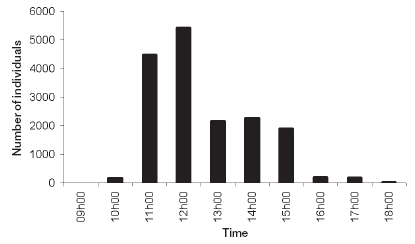 Figure 3 : Diurnal pattern of Oriental Honey-buzzard Pernis ptilorhyncus migration at Tanjung Tuan, Malaysia, during 1998–2001. 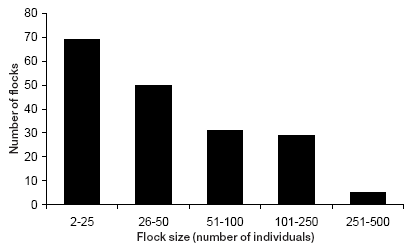 Figure 4 : Frequency distribution of migrant Oriental Honey-buzzard Pernis ptilorhyncus flocks at Tanjung Tuan, Malaysia in 2000–2001. |
||||
| DISCUSSION Our observations confirm previous records of significant numbers of migrant raptors at Tanjung Tuan, e.g. L. A. Tiah (in litt. 2002) counted 5,093 migrating Oriental Honey-buzzards (112 birds/hour) in early March 1998, and 1,040 (63.7 birds/hour) in early March 1999. Our maximum hourly totals also accord with previous records: 680 individuals/hour on 3 March 1964 (Medway and Nisbet 1965), 670 on 2 March 1998 and 616 on 4 March 1998 (L. A. Tiah in litt. 2002). We observed the largest daily numbers of Oriental Honey-buzzards in early March. Since 1955, daily totals of Oriental Honey Buzzards at Tanjung Tuan exceeded 1,000 individuals on: 1 March 1987 (2,761: J. M. Thiollay quoted in Wells 1999), 2 March 1998 (1,516: L. A. Tiah in litt. 2002), 2 March 2001 (1,758: this study), 3 March 2001 (1,285: this study), 4 March 1983 (1,552: see Wells 1990a), 4 March 1998 (1,115: L. A. Tiah in litt. 2002), 6 March 2001 (1,222: this study), 15 March 2000 (1,136: this study), 26 March 1964 (1,200: see Medway and Nisbet 1965) and 27 March 1964 (1,602: see Medway and Nisbet 1965). The first Oriental Honey-buzzard migrants of the season have been seen as early as late January (Medway and Wells 1976) to 13 February (Oakeley 1955), and as late as 2 April (White 1961, Wells 1990a), and 3 April further south over Singapore (Hurrell 1961). Other authors have recorded earlier and later dates of migrant raptors than those we recorded, reflecting the limited duration of our visits. Wells (1999) noted the earliest Chinese Goshawks around Tanjung Tuan on 3 February, and the latest on 15 April, while C. Nualsri (in litt. 2005) recorded 84% of individuals of this species at Chumphon, Thailand, during 28–30 March 2005. Wells (1999) recorded Japanese Sparrowhawk at Tanjung Tuan from 15 February to early May, with peak passage on 21 March–15 April. For Black Baza, 96% of migrants were seen during 16–30 March at Chumphon, Thailand (C. Nualsri in litt. 2005). For Grey-faced Buzzard, the earliest migrants at Hulu Klang (Selangor) near Kuala Lumpur were on 17 February 2006 (M. Chong in litt. 2006), while migration peaked in early to mid-March at Chumphon, with 79% of individuals during 8–19 March in 2005 (C. Nualsri in litt. 2005). Five additional raptor species have been recorded migrating at the site: Osprey Pandion haliaetus, Blackshouldered Kite, Black Kite Milvus migrans, Eastern Marsh Harrier Circus (aeruginosus) spilonotus and Common Buzzard Buteo buteo (Wells 1990a, 1999, Zalles and Bildstein 2000). Non-raptor migrants (including Bluetailed Bee-eater Merops philippinus and Blue-throated Beeeaters M. viridis) have been described elsewhere (DeCandido et al. 2004a,c). Our findings with regard to wind direction and wind speed in relation to raptor migration generally agree with Wells (1990a, 1999). Usually, raptors made landfall nearest the lighthouse when winds were light and had a westerly component. When westerly winds exceeded 10 km/h, greater numbers of migrating raptors were sometimes counted 6 km south at Kampung Segenting (L. A. Tiah in litt. 2002). When winds were north-easterly, raptors tended to drift further north up the coast. However in early March, light winds from other directions occasionally produced significant numbers of migrating honey-buzzards: during 14h00–15h00 on 2 March 2001, we counted 809 Oriental Honey-buzzards on east–northeast winds of 2–10 km/h. The following day with similar winds, we counted 377 honey-buzzards during 11h00–12h00, with much of the migration passing to the north. When winds switched to south–south-east by 13h00, we counted 801 honey-buzzards, mostly passing to the south. Our observations of the diurnal timing of raptor migration, which showed a clear peak at 11h00–13h00 (Fig. 3), closely agree with those of Wells (1990a). Possible explanations for this peak include: (a) the location of appropriate roosting areas in north-eastern Sumatra; (b) the timing of the onset of thermals in coastal Sumatra; and (c) the timing of changes in meteorological conditions, especially wind direction and speed, at Tanjung Tuan. All of these warrant additional investigation, as do the factors that initiate movements of particularly large numbers Oriental Honey-buzzards. Compared to Agostini et al. (2005), who found that 82% of Eurasian Honey-buzzard Pernis apivorus flocks crossed the Tyrrhenian Sea from Cape Bon (Tunisia) to mainland Italy during 12h00–15h00, we found that the majority of Oriental Honeybuzzard flocks (52%) made landfall from 11h00–13h00. The difference was probably because the European birds had to make a much longer (>150 km) sea crossing. The total numbers of migrant raptors each year at Tanjung Tuan is still not known, because observations have only been for only relatively brief periods of time per season (single day counts in the 1950s, three days in 1964, six days in 1983, and 15 days in 2000 and 11 days in2001). On 3–6 March 2001, MNS members formed a north–south team of observers (an ‘interception line’) stationed along the coast stretching from 6 km south of the Tanjung Tuan at Kampung Segenting to the northern part of Port Dickson town. They found that 28% (of 4,302) migrating Oriental Honey-buzzards made landfall north and south of Tanjung Tuan. Based on these data, the totals we counted, and the limited duration of our observations in the two seasons, we estimate that 10,000–20,000 Oriental Honey-buzzards make the crossing from Sumatra to the west coast of Malaysia each spring. By comparison, Medway and Wells (1976) estimated that c.180,000 Oriental Honey-buzzards migrated south over west peninsular Malaysia in autumn 1963. Recent observations in spring at Tanjung Tuan suggest daily maxima of 1,500–1,800 individuals are likely at Tanjung Tuan, with both historical and recent counts indicating that the peak of the Oriental Honey-buzzard migration is likely to be in early March. Overall, the number of Oriental Honey-buzzards counted at Tanjung Tuan are similar to spring counts of migrating Eurasian Honey-buzzards making long (>15 km) sea crossings at Italy and Gibraltar (Giordano 1991, Agostini 1992, Zalles and Bildstein 2000), and recent autumn migration counts of Oriental Honey-buzzards in Thailand (DeCandido et al. 2004b). We recommend the following: (1) a season-long count from mid-February to mid-May should be conducted by experienced observer(s) in order to determine the magnitude of the migration of all raptor species; (2) in early March, a north–south ‘interception line’ of observers perpendicular to the line of migration should be set up from several kilometres north of the lighthouse in Port Dickson to several kilometres south of the lighthouse in order to validate the percentage of migrants that are not observed from Tanjung Tuan; (3) a ringing programme should be established to determine the condition, age and sex of individuals arriving through the season; (4) a watch site should be set up in a highly accessible location (e.g. the grounds of a hotel) near Tanjung Tuan, coinciding with demonstrations involving captive birds of prey. Most people in Malaysia are unaware of the great diversity of migrant species that pass through their country in spring and autumn. Using the spectacle of raptor migration at Tanjung Tuan combined with live, captive birds of prey affords a significant opportunity to make many influential people aware of this annual phenomenon in the area of Port Dickson. |
||||
| ACKNOWLEDGEMENTS We dedicate this research to the late Laurence Poh and his wife, Audrey. We greatly appreciate the encouragement and thoughtful advice of members of the Malaysian Nature Society including Ooi Beng Yean and Liew Siew Lan, Chiu Sein Chiong and Regina Anthony, Cheang Kum Seng, Dr. Chan Kai Soon, Mike Chong, Lim Aun Tiah and Lim Kim Chye. Chukiat Nualsri provided information regarding spring migrating raptors near Chumphon, Thailand. Anne Arrowsmith designed the maps. David Wells provided many helpful comments and ideas. William Duckworth critically read the manuscript and directed us to historical information about bird migration in South-East Asia. We wish to acknowledge the hospitality shown to us by members of the Tanjung Tuan lighthouse staff. This is Hawk Mountain Sanctuary Contribution to Conservation Science number 132. Forktail 22 (2006) SHORT NOTES 159. |
||||
| REFERENCES Agostini, N. (1992) Spring migration of Honey Buzzards (Pernis apivorus) at the Straits of Messina in relation to atmospheric conditions. J. Raptor Research 26: 93–96. Agostini, N., Panuccio, M. and Massa, B. (2005). Flight behaviour of Honey Buzzards (Pernis apivorus) during spring migration over the sea. Buteo 14: 3–9. Clark, W. S. (1999) A field guide to the raptors of Europe, the Middle East and North Africa. New York: Oxford University Press. DeCandido, R., Allen, D. A and Yosef, R. (2004a) Merops migration at Tanjung Tuan, Malaysia: an important spring bee-eater migration watch site in Southeast Asia. J. Yamashina Inst. Orn. 36: 15–21. DeCandido, R., Nualsri, C. N., Allen, D. A. and Bildstein, K. L. (2004b) Autumn 2003 raptor migration at Chumphon, Thailand: a globally significant raptor migration watch site in South-East Asia. Forktail 20: 41–47. DeCandido R., Allen, D. A. and Bildstein, K. L. (2004c) A comparison of spring migration phenology of bee-eaters and Oriental Honeybuzzards Pernis ptilorhyncus at Tanjung Tuan, Malaysia, 2000–01. Ardea 92: 169–174. Giordano, A. (1991) The migration of birds of prey and storks in the Straits of Messina. Birds of Prey Bull. 4: 239–250. Higuchi, H., Shiu, H. J., Nakamura, H., Uematsu, A., Kuno, K., Saeki, M., Hotta, M., Tokita, K. I., Moriya, E., Morishita, E. and Tamura, M. (2005) Migration of Honey-buzzards Pernis apivorus based on satellite tracking. Orn. Sci. 4: 109–115. Hurrell, L. H. (1961) Migration and movements of birds of prey over Singapore. Bull. Nat. Mus. Singapore 30: 97–100. Inskipp, T., Lindsey, N. and Duckworth, W. (1996) An annotated checklist of the birds of the Oriental Region. Sandy, U.K.: Oriental Bird Club. Jeyarajasingham, A. and Pearson, A. (1999) A field guide to the birds of West Malaysia and Singapore. New York: Oxford University Press. McClure, H.E. (1998) Migration and survival of the birds of Asia. Revised edition. Bangkok: White Lotus Press. Medway, L. and Nisbet, I. C. T. (1964) Bird report: 1963. Malayan Nature J. 18: 133–171. Medway, L. and Nisbet, I. C. T. (1965) Bird report: 1964. Malayan Nature J. 19:160–194. Medway, L. and Wells, D.R. (1976) The birds of the Malay peninsula. Vol. 5. Conclusion, and survey of every species. London: H. F. & G. Witherby. Oakely, R. N. (1955) Migrating hawk-eagles. Malayan Nature J. 10: 163–64. Porter, R. F., Willis, L., Christensen, S. and Nielsen, B. P. (1986) Flight identification guide to European raptors. 3rd ed. Calton, U.K: T. and A. D. Poyser. Wells, D. R. (1990a) Malayan bird report: 1982 and 1983. Malayan Nature J. 43: 116–147. Wells, D. R. (1990b) Malayan bird report: 1986 and 1987. Malayan Nature J. 43: 172–185. Wells, D. R. (1999) The birds of the Thai-Malay peninsula. London, U.K: Academic Press. White, D. H. S. (1961) Migrating raptors. Malayan Nature J. 15: 181. Zalles, J. I. and Bildstein, K. L. (2000) Raptor watch: global directory of raptor migration sites. Cambridge, U.K. and Kempton, U.S.A.: BirdLife International and Hawk Mountain Sanctuary. |
||||
| Kindly
submitted by: Robert DeCandido, Acopian Center for Conservation Learning, Hawk Mountain Sanctuary, 410 Summer Valley Road, Orwigsburg, Pennsylvania 17961 U.S.A. Correspondence: 1831 Fowler Avenue, The Bronx, New York 10462-3708 U.S.A. Email: rdcny@earthlink.net Deborah Allen, P.O. Box 1452 Peter Stuyvesant Station, New York 10009 U.S.A. Email: dallenyc@earthlink.net Keith L. Bildstein, Acopian Center for Conservation Learning, Hawk Mountain Sanctuary, 410 Summer Valley Road, Orwigsburg, Pennsylvania 17961 U.S.A. Email: bildstein@hawkmtn.org |
||||
| Tweet | ||||
| |

A Guide to Birdwatching in Thailand. Copyright © 2004-2017 thaibirding.com. All rights reserved.
